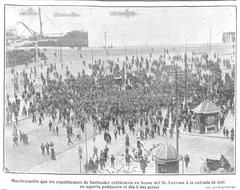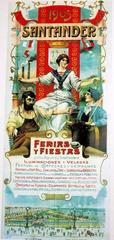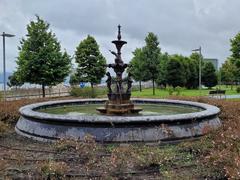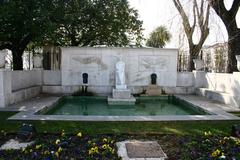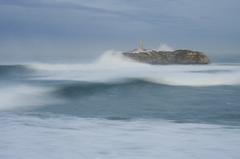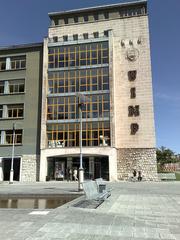
Comprehensive Guide to Visiting Santander, Cantabria, Spain
Date: 14/08/2024
Captivating Introduction
Welcome to Santander, a coastal gem where the whispers of ancient mariners blend seamlessly with the hum of modern life. Imagine walking through streets that echo with the footsteps of Roman soldiers and medieval monks, while the scent of fresh seafood wafts through the air. Santander, the capital of Cantabria in northern Spain, offers a unique blend of historical richness, architectural beauty, and natural splendor. From its early days as Portus Victoriae during the Roman Empire to its transformation into a bustling port city in the 19th century, Santander is a living tapestry of history and culture (turismo.santander.es) (britannica.com) (Wikipedia).
But Santander is not just about its past. It continually reinvents itself, emerging from the ashes of the devastating 1941 fire to become a vibrant cultural hub. Whether you’re drawn to architectural marvels like the English-inspired Palacio de la Magdalena or the modern Centro Botín designed by Renzo Piano, or you prefer the serene beauty of its beaches and parks, Santander has something for everyone (touristplatform.com) (Lonely Planet).
As you explore this guide, you’ll uncover not just the well-known attractions but also hidden gems and local secrets that make Santander a truly special destination. From the prehistoric caves of Altamira to the lively festivals that bring the city to life, Santander is a place where every corner holds a story waiting to be discovered (theworldwasherefirst.com). So grab your walking shoes and sense of adventure, and get ready to dive deep into the heart of Santander. And don’t forget to download Audiala, your perfect travel companion, offering expertly crafted audio guides that will make your journey even more enriching. Let’s get started on this unforgettable adventure!
Table of Contents
- Historical Background
- Early History and Roman Influence
- Medieval Period
- The Castile Era and Urban Expansion
- 20th Century Developments
- Modern Era and Cultural Significance
- Architectural and Cultural Landmarks
- Disasters and Reconstruction
- Economic and Industrial Development
- Cultural and Artistic Trends
- Historical Sites and Museums
- Prehistoric Caves and Nearby Attractions
- Architectural and Cultural Significance of Santander, Cantabria, Spain
- Natural Beauty and Outdoor Activities in Santander, Cantabria, Spain
- Beaches
- Magdalena Peninsula
- Cabárceno Natural Park
- Picos de Europa National Park
- Coastal Walks
- Water Sports
- Cycling
- Parks and Gardens
- Altamira Caves
- Day Trips
- Nightlife
- Festivals and Events
- Culinary Delights
- Mercado de la Esperanza
- Santander Cathedral
- Paseo Maritimo
- Pop Culture References
- Interactive Activities
- Local Lingo Lessons
- FAQ Section
- Practical Information with a Twist
Historical Background
Early History and Roman Influence
Did you know that Santander’s history stretches back to the Roman Empire? Yes, you heard it right! Imagine wandering through a city where history peeks around every corner, dating back to 26 BC during the Cantabrian Wars. Here, Emperor Augustus sought victory over the Cantabrians at the Portus Victoriae (Port of Victory). Archaeological remains from the 1st century AD further testify to this ancient settlement (turismo.santander.es).
Medieval Period
Fast forward to 1068, and you’ll find the first documented mention of Santander in a privilege granted by Sancho II to the monastery of San Emeterio. The city’s name derives from the Latin ‘Sancti Emeterii.’ By 1187, Santander had become an abbot’s town, receiving a charter from Alfonso VIII. The city’s navy even captured Seville in 1248, earning a coat of arms featuring the Torre del Oro and the Guadalquivir River (turismo.santander.es).
The Castile Era and Urban Expansion
Picture this: the 19th century, a period of significant urban expansion for Santander. Despite challenges like the Napoleonic invasion and epidemics, the city thrived. The flourishing flour trade and colonial imports led to the establishment of the railway between Alar del Rey and Santander. The port’s bustling activity earned it the nickname ‘the Liverpool of Spain.’ In 1857, the Banco de Santander was founded (turismo.santander.es).
20th Century Developments
By the late 19th century, Santander was blossoming into a tourist destination. The Baños de Ola baths gained fame for their therapeutic waters, first advertised in 1846. The city became a favorite retreat for notable figures like Benito Pérez Galdós, who built his house, San Quintín, here (turismo.santander.es).
Modern Era and Cultural Significance
Fast forward to 1981, and you’ll find the opening of the Museo Marítimo del Cantábrico, reflecting Santander’s rich maritime tradition. In 1983, Santander became the capital of Cantabria, coinciding with Cantabria’s constitution as an Autonomous Community (turismo.santander.es).
Architectural and Cultural Landmarks
Santander boasts several architectural marvels. The Magdalena Palace, built in 1909, served as a summer residence for the Spanish Royal Family and now functions as a museum (touristplatform.com). The Gothic-style Cathedral of Our Lady of the Assumption, constructed in the 13th century, is another cornerstone of the city’s religious heritage (touristplatform.com).
Disasters and Reconstruction
In 1941, a devastating fire swept through Santander’s city center, fueled by a windstorm. The city rebuilt itself, preserving landmarks like the Magdalena Palace, the Gothic cathedral, and the library of historian Marcelino Menéndez y Pelayo (britannica.com).
Economic and Industrial Development
Santander’s economy is a vibrant mix of tourism, fishing, heavy industry, and port activities like shipbuilding. It also boasts significant manufacturing sectors and agriculture, particularly cattle raising. The bay’s industrial landscape is marked by large warehouses, with other major industries including finance, public administration, and healthcare (britannica.com).
Cultural and Artistic Trends
Santander embraces modern cultural and artistic trends, exemplified by the Botín Centre, designed by Renzo Piano. It’s also a family-friendly destination with activities like boat trips, visits to the La Magdalena mini zoo, and the Maritime Museum. Popular beaches include El Sardinero, El Camello, Mataleñas, La Concha, and Los Peligros (spain.info).
Historical Sites and Museums
Dive into Santander’s rich history with visits to the Palacio de la Magdalena, the Mercado del Este, Paseo de Pereda, and Plaza Porticada. Museums like the Cantabria Museum, Menéndez Pelayo Library, and the Marítimo del Cantábrico Maritime Museum offer a deep dive into the city’s cultural tapestry (touristplatform.com).
Prehistoric Caves and Nearby Attractions
Santander is your gateway to prehistoric caves like Altamira and El Castillo, featuring mesmerizing cave paintings. Nearby, the seaside town of Castro Urdiales, with its colorful fisherman’s cottages and the medieval Santa Ana Castle, is a must-visit (theworldwasherefirst.com).
Conclusion
Ready to uncover Santander’s secrets? From its ancient roots to its modern charm, this city offers a treasure trove of experiences. Download the Audiala app to explore Santander’s hidden gems and stories with expertly crafted audio guides. Dive deep into the city’s history, culture, and natural beauty for an unforgettable adventure.
Architectural and Cultural Significance of Santander, Cantabria, Spain
Historical Background
Imagine a city where the sea whispers secrets of ancient mariners and stone streets echo tales of royal summers—welcome to Santander, a hidden gem on Spain’s northern coast. Santander’s origins date back to ancient times, with evidence of settlements from the Roman period when it was known as Portus Victoriae. The city gained prominence as a trading port in the 12th century and has since evolved through various historical phases, including significant transformations during the Middle Ages. One of the most notable events in its history was the Great Fire of 1941, which destroyed much of the medieval city. Despite this setback, Santander has managed to rebuild itself into a vibrant city that blends historical and modern architectural styles (Wikipedia).
Architectural Highlights
Palacio de la Magdalena
Trust me, when it comes to stunning views and history, Santander doesn’t just play the game—it rewrites the rules! The Palacio de la Magdalena is one of Santander’s most iconic landmarks. Built between 1908 and 1912, this English-inspired palace was a gift from the city to the Spanish royal family. It served as their summer residence and is now open to the public, hosting various exhibitions and cultural events. The palace is situated on the Magdalena Peninsula, offering stunning sea views and a sprawling parkland perfect for leisurely strolls (PlanetWare).
Centro Botín
Opened in 2017, the Centro Botín is a modern arts and cultural center designed by the renowned Italian architect Renzo Piano. This futuristic two-block structure is built on stilts and is centrally positioned between Santander’s Pereda Gardens and the waterfront. The center hosts a variety of art exhibitions and cultural events, making it a must-visit for art enthusiasts (Lonely Planet).
Challenge: While you’re here, try to find the hidden mural in the old town that locals say brings good luck!
Catedral de la Asunción
Santander’s Gothic-style cathedral, the Catedral de la Asunción, comprises two churches built one above the other. The upper church, dating back to the 14th century, was extensively rebuilt after the 1941 fire. The lower church, known as Iglesia del Santísimo Cristo, dates back to the 13th century and features glass floors that reveal archaeological remains. This cathedral is a serene and historically significant site that offers a glimpse into the city’s medieval past (PlanetWare).
Gran Casino del Sardinero
The Gran Casino del Sardinero, established in 1916, epitomizes the stately, turn-of-the-century air of Santander. Located near the El Sardinero beaches, this casino is a prime example of the city’s luxurious past and continues to be a popular destination for both locals and tourists (The Crazy Tourist).
Cultural Institutions
Museo Marítimo del Cantábrico
The Museo Marítimo del Cantábrico is one of Santander’s most popular attractions. This maritime museum offers an in-depth look into the region’s seafaring history, featuring navigation instruments, nautical maps, and a 60-ton whale skeleton. The museum spans four floors and is a highlight for history buffs and maritime enthusiasts alike (The Spain Travel Guru).
Museum of Prehistory and Archaeology of Cantabria
This museum showcases Cantabria’s rich archaeological heritage with interactive multimedia displays. Many exhibits feature artifacts from the region’s prehistoric caves, offering a fascinating insight into Paleolithic times. The museum is a must-visit for those interested in archaeology and ancient history (PlanetWare).
Centro Arqueológico Muralla de Santander
The Centro Arqueológico Muralla de Santander is another significant cultural site. This archaeological center reveals the ancient city walls and offers a unique perspective on Santander’s historical development. The center uses modern technology to enhance the visitor experience, making it both educational and engaging (Lonely Planet).
Festivals and Cultural Events
Festival Intercultural de las Naciones
The Festival Intercultural de las Naciones is a major cultural event in Santander, celebrating the city’s diversity and artistic talent. Held annually from August to September, the festival features over 70 live performances, 500 artists, and 250 hours of music. It also includes a variety of gastronomic offerings from countries like Paraguay, Korea, and Turkey, with the Dominican Republic as the guest country for 2024 (Santander Creativa).
La Plaza Santander
La Plaza Santander is another significant cultural event, held in September. The festival features performances by renowned artists and groups, including Malú, Rozalén, and Sergio Dalma. It aims to enhance the city’s cultural life and contribute to the desestacionalización (de-seasonalization) of tourism by offering a rich cultural program outside the peak summer months (Santander Creativa).
Visitor Tips
Best Time to Visit
Santander enjoys a mild climate typical of the Spanish northern coastline, with frequent rainfall and stable temperatures. The best time to visit is during the summer months, from June to September, when the weather is warm and ideal for beach activities and outdoor events (Wikipedia).
Getting Around
Santander is a walkable city with broad streets and scenic promenades. Bicycles are also a popular mode of transport, especially along the waterfront and park areas. Public transportation, including buses and ferries, is readily available for exploring the city and its surroundings (Ursula’s Weekly Wanders).
Local Cuisine
Fish and seafood dominate the local cuisine, reflecting Santander’s maritime heritage. Visitors should not miss trying the Cantabrian anchovies, which are famous throughout Spain. For a true local experience, visit the Mercado La Esperanza early in the morning and watch the city wake up with the smell of fresh seafood (The Crazy Tourist).
Notable Landmarks
El Sardinero
El Sardinero is a pair of golden sandy beaches that stretch over a kilometer in length. This area is perfect for sunbathing, swimming, and enjoying the moderate waves. The nearby promenade and resort area exude a stately, turn-of-the-century charm, epitomized by the Gran Casino (The Crazy Tourist).
Parque de la Naturaleza Cabárceno
Located 18km south of Santander, this open-air zoo is set in a former pit mine and covers over 1,900 acres. It features a range of animal species, both native and exotic, living in semi-captivity. The park offers a unique opportunity to observe animal behavior in a naturalistic setting (The Crazy Tourist).
Playa del Puntal
Playa del Puntal is a 2km-long finger of sand that juts across the bay towards Santander. It is an idyllic spot for beachgoers, offering calm waters and stunning views. However, visitors should be cautious of the currents (Lonely Planet).
Seasonal Highlights
In summer, Santander’s beaches come alive, but visit in winter to experience the cozy charm of its Christmas markets. Santander, with its rich history, diverse architecture, and vibrant cultural scene, offers a unique blend of experiences for visitors. From exploring historical landmarks to enjoying modern cultural events, the city provides a memorable and enriching travel experience.
Call to Action
Ready to uncover Santander’s secrets? Download Audiala now and let your journey begin. Your perfect travel companion awaits!
Natural Beauty and Outdoor Activities in Santander, Cantabria, Spain
Welcome to Santander, where the charm of the Cantabrian coast meets the vibrancy of Spanish culture! Nestled in northern Spain, Santander is a treasure trove of natural beauty and outdoor activities waiting to be explored. Whether you’re a beach bum, a history buff, or an adventure seeker, Santander has something for everyone. Let’s dive into this coastal paradise!
Beaches
Santander boasts some of the most beautiful beaches in northern Spain. The most popular ones are Playa de la Magdalena and Playa del Sardinero. Playa de la Magdalena, located near the Magdalena Peninsula, offers calm waters, making it perfect for families (Only By Land). Playa del Sardinero, divided into two sections, is known for its golden sand and excellent facilities, including restaurants, bars, and water sports rentals. For a more secluded experience, head to Playa de Mataleñas, a small, picturesque beach surrounded by cliffs and greenery, offering a tranquil escape from the city’s hustle and bustle (Only By Land).
Magdalena Peninsula
The Magdalena Peninsula is a must-visit for nature lovers. This 24.5-hectare parkland is perfect for picnics or leisurely walks. The peninsula is also home to the beautiful Palacio de la Magdalena, a former royal palace built in the 20th century. The palace’s interiors are opulent, and its gardens are expansive (The Common Wanderer). The peninsula offers incredible views overlooking Isla de Mouro, the Santander coastline to El Sardinero beach, and the Bay of Santander.
Cabárceno Natural Park
A short drive from Santander, the Cabárceno Natural Park is a vast wildlife park set in a former iron ore mining area. The park is home to over a hundred animal species from five continents, including elephants, lions, gorillas, and brown bears. The park’s unique landscape, with its striking rock formations and extensive green areas, provides a beautiful backdrop for hiking and wildlife watching. Visitors can explore the park on foot, by bike, or take a scenic cable car ride for panoramic views (Only By Land).
Picos de Europa National Park
The nearby Picos de Europa National Park offers stunning hiking trails with breathtaking views of the mountains and valleys. This park is a haven for outdoor enthusiasts, offering activities such as hiking, climbing, and bird watching. The park’s diverse flora and fauna make it a perfect destination for nature lovers (Totally Spain).
Coastal Walks
Starting at El Faro lighthouse (Faro de Cabo Mayor) on the outskirts of Santander, visitors can follow the coastline all the way to the quaint coastal town of La Maruca. Along the way, there are various hidden coves for a quick swim and stunning coastal views to admire. Although challenging in parts, the walk is leisurely and offers a perfect opportunity to enjoy the natural beauty of Santander’s coastline (The Common Wanderer).
Water Sports
The bay of Santander is perfect for sailing, kayaking, and paddleboarding. The calm waters and beautiful scenery make it an ideal location for water sports enthusiasts. Several local companies offer equipment rentals and guided tours, making it easy for visitors to enjoy these activities (Totally Spain).
Cycling
Santander provides numerous opportunities for cycling, with several scenic routes available for all levels of cyclists. The city’s bike-friendly infrastructure and beautiful landscapes make it a great destination for cycling enthusiasts. Visitors can rent bikes from local shops and explore the city and its surroundings at their own pace (Totally Spain).
Parks and Gardens
Santander is home to several beautiful parks and gardens, perfect for a relaxing day outdoors. The Pereda Gardens are a popular spot for both locals and tourists, offering a peaceful retreat in the heart of the city. The gardens are located near the Centro Botín, a contemporary arts and cultural center designed by renowned architect Renzo Piano. Visitors can enjoy a coffee from El Muelle café underneath the center while soaking up gorgeous views of the bay (Totally Spain).
Altamira Caves
The Cuevas de Altamira (Altamira Caves), a UNESCO World Heritage Site, were discovered in 1869 and are known for their prehistoric cave paintings. The earliest engravings, including those of bison, are about 14,000 to 20,000 years old. The vivid colors and remarkable level of detail in the paintings are notable, considering the tools available during that era. Preservation of the cave is of utmost importance, which means that admission is limited to just five people per week via lottery (I Spy Spain).
Day Trips
Santander is also a great base for exploring the wider region of Cantabria. A day trip to the picturesque village of Santillana del Mar is highly recommended. Known for its medieval architecture and the nearby Altamira Cave, Santillana del Mar offers a glimpse into the region’s rich history. Another worthwhile excursion is to the coastal town of Comillas, home to the stunning modernist architecture of El Capricho, designed by Antoni Gaudí (Totally Spain).
Nightlife
Santander offers a vibrant nightlife scene with a variety of bars, pubs, and clubs to suit all tastes. Start your evening with a stroll along the waterfront and enjoy a cocktail at one of the stylish beach bars. For a lively atmosphere, head to the Cañadío Square, where you’ll find numerous bars and clubs playing everything from traditional Spanish music to contemporary hits (Only By Land).
Festivals and Events
The city’s vibrant cultural calendar includes numerous festivals and events. The Santander International Festival, held every summer, features performances by renowned artists in music, dance, and theater. The Semana Grande (Big Week) in July is another highlight, offering parades, concerts, and fireworks that bring the city to life (Totally Spain).
Culinary Delights
Santander’s culinary scene is another highlight. Seafood lovers will be in paradise with the city’s fresh catches, such as rabas (fried squid), marmita (a traditional Cantabrian tuna stew), and the famous anchovies from Santoña. Pair your meal with a local wine or cider for a truly authentic experience. The city’s tapas bars and restaurants offer a range of delicious options that showcase the best of Cantabrian cuisine (Totally Spain).
Mercado de la Esperanza
One of the city’s highlights is the Mercado de la Esperanza, the municipal food market directly behind the Town Hall. Visitors will be amazed at the color, character, and variety of local produce on offer. The market is a great place to enjoy the architecture and the wonderful cheeses and hams (Totally Spain).
Santander Cathedral
The Santander Cathedral is well worth a visit. Composed of two Gothic churches, one above the other, construction began in the 13th century and was completed in the 14th. The lower crypt consists of the Church of El Cristo, the oldest monument in the city. The crypt contains the 13th-century Iglesia del Santismo Cristo, where it’s possible to view relics of Santander’s patron saints, including San Emeterio and San Celedonio (The Common Wanderer).
Paseo Maritimo
Stroll along the waterside known as the Paseo Maritimo and look out for the beautifully sculpted Raqueros figures by Jose Cobo Calderon, honoring the children who once dived into the bay to collect coins tossed by tourists. The Museum of Prehistory and Archaeology stands as a testament to Santander’s commitment to preserving and celebrating its heritage. On display are archaeological wonders, including intricately carved cave art and meticulously crafted tools (Totally Spain).
Pop Culture References
Did you know that Santander has featured in various artistic works? The city is mentioned in the famous Spanish song “Santander” by Jorge Sepúlveda, which evokes the charm and allure of this coastal paradise. Moreover, the beauty of Santander has inspired numerous Spanish writers and filmmakers, adding a layer of cultural richness to your visit.
Interactive Activities
For those who love challenges, why not embark on a scavenger hunt? Try to find all the hidden statues scattered across the city or challenge yourself to discover the best viewpoint in Santander. Don’t miss the Raqueros figures at the Paseo Maritimo and see if you can capture the perfect photo.
Local Lingo Lessons
To enhance your experience, here are a few key phrases in Spanish and local Cantabrian slang:
- “Hola, ¿cómo estás?” (Hello, how are you?)
- “¿Dónde está la playa?” (Where is the beach?)
- “¡Qué guay!” (How cool!)
- “Rabas, por favor” (Fried squid, please)
- “¡Vamos a la fiesta!” (Let’s go to the party!) These phrases will surely help you connect with locals and make your visit more enjoyable.
FAQ Section
Q: What’s the best time to visit Santander? A: The best time to visit Santander is during the summer months (June to August) when the weather is warm and ideal for beach activities. Spring and early autumn are also great for enjoying outdoor adventures without the summer crowds.
Q: Are there any local customs I should be aware of? A: In Santander, it’s customary to greet people with a kiss on each cheek. Also, remember that dinner in Spain is typically served later than in other countries, often around 9 PM or later.
Practical Information with a Twist
- Weather Patterns: Santander enjoys a mild climate year-round. Here’s a fun rhyme to remember: “Sunny days in June and July, bring your shades and don’t be shy!”
- Travel Tips: To explore Santander, hop on a bike or take a hike! With scenic routes and friendly locals, your adventure will be full of focal points.
By exploring these natural beauties and engaging in outdoor activities, visitors to Santander can experience the city’s unique charm and make unforgettable memories. And don’t forget, to truly unlock the secrets and stories of Santander, download Audiala. Our beautifully crafted audio guides will enhance your exploration experience, ensuring you don’t miss a thing!
Call to Action
As our journey through Santander comes to an end, it’s clear that this city is more than just a destination; it’s an experience that engages all your senses and leaves you with unforgettable memories. From the ancient ruins that whisper tales of Roman conquests to the bustling markets filled with the aroma of freshly caught seafood, Santander offers a rich tapestry of history, culture, and natural beauty.
This guide has taken you through the historical milestones that have shaped the city, from its Roman origins to its modern-day vibrancy. We’ve explored architectural masterpieces like the Palacio de la Magdalena and the contemporary Centro Botín, and delved into the city’s cultural institutions that celebrate its maritime heritage (turismo.santander.es) (PlanetWare).
But Santander is not just about looking back; it’s about living in the moment and enjoying the myriad of outdoor activities and natural wonders it offers. Whether you’re hiking in the Picos de Europa, sunbathing on Playa del Sardinero, or exploring the lush landscapes of the Magdalena Peninsula, Santander’s natural beauty is a constant invitation to connect with the great outdoors (Only By Land) (Totally Spain).
And let’s not forget the vibrant cultural scene, from the Festival Intercultural de las Naciones to the lively nightlife that keeps the city buzzing long after the sun sets. Every street, every plaza, and every beach has its own story, its own charm, and its own secret waiting to be discovered (Santander Creativa) (Only By Land).
So, are you ready to uncover the secrets of Santander? Download Audiala now and let our expertly crafted audio guides lead you through the hidden gems and untold stories of this remarkable city. With Audiala, your exploration of Santander will be deeper, richer, and more rewarding. Don’t miss out on the adventure of a lifetime!
References
- turismo.santander.es. Discover the City: History. Retrieved from turismo.santander.es.
- Britannica. Santander, Spain. Retrieved from britannica.com.
- Wikipedia. Santander, Spain. Retrieved from Wikipedia.
- Tourist Platform. 10 Historical Places to Visit in Santander. Retrieved from touristplatform.com.
- Lonely Planet. Santander Attractions. Retrieved from Lonely Planet.
- The World Was Here First. Santander Itinerary. Retrieved from theworldwasherefirst.com.
- PlanetWare. Tourist Attractions in Santander. Retrieved from PlanetWare.
- Only By Land. Things to Do in Santander. Retrieved from Only By Land.
- Totally Spain. Destination: Santander. Retrieved from Totally Spain.
- Santander Creativa. Festival de las Naciones 2024. Retrieved from Santander Creativa.
